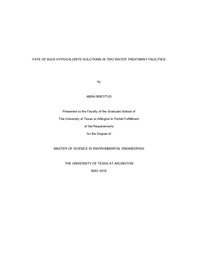
ATTENTION: The works hosted here are being migrated to a new repository that will consolidate resources, improve discoverability, and better show UTA's research impact on the global community. We will update authors as the migration progresses. Please see MavMatrix for more information.
Show simple item record
| dc.contributor.author | Breytus, Anna | en_US |
| dc.date.accessioned | 2015-07-31T22:10:17Z | |
| dc.date.available | 2015-07-31T22:10:17Z | |
| dc.date.submitted | January 2015 | en_US |
| dc.identifier.other | DISS-13150 | en_US |
| dc.identifier.uri | http://hdl.handle.net/10106/25094 | |
| dc.description.abstract | Measurement of oxyhalides in various strength hypochlorite solutions has been an issue of importance in the last decade, especially in view of the current aim of Homeland Security to reduce the usage of chlorine gas. Hypochlorite solutions have a potential of introducing disinfection by-products when used for water treatment. Previous works have shown the possibility of high levels of chlorate and perchlorate in high strength hypochlorite solutions. Perchlorate is an endocrine disruptor that inhibits iodide intake by the thyroid, thus reducing the production of essential thyroid hormones. Chlorate also has several adverse effects on the blood and thyroid systems. Perchlorate is regulated in the states of Massachusetts and California at the levels of 2 ppb and 6 ppb respectively, and is being considered for federal regulation at the level of 15 ppb. Chlorate has a health reference limit (HRL) of 210 ppb and a proposed action level of 200 ppb in California, with a current notification level of 800 ppb in California. Chlorate is also being considered for federal regulation with a level yet to be determined. Chlorate and perchlorate measurement was done using ion chromatograph (IC) with carbonate eluent and conductivity detector. Due to the sensitivity limitations of the system, it was desired to measure some of the samples without dilution. This required the removal of free chlorine from the solution (quenching) to prevent destruction of system components, such as the column and the suppressor. Chlorine removal was achieved by addition of 20% excess hydrogen peroxide, based on molar ratio of 1:1 to chlorine and subsequent catalytic removal of residual hydrogen peroxide, which is also detrimental to IC equipment, using manganese dioxide. The process showed consistent and reproducible results.One objective of this study was to investigate the degree to which hypochlorite solutions degrade, and the increase in chlorate and perchlorate levels in storage tanks. This was accomplished by comparing chlorine, chlorate and perchlorate levels in storage tanks to newly delivered solutions. Two facilities that had different suppliers were sampled. For both suppliers, variations in chlorine and chlorate levels were found in different hypochlorite deliveries. One of the suppliers generally had a much higher chlorate level in hypochlorite than the other supplier. Chlorine concentrations were equal or greater than the declared trade percent for both suppliers. Variations were also found in hypochlorite and chlorate concentrations stored at each facility. From a comparison between stored and newly delivered material it was found that significant hypochlorite degradation takes place. This results in increase of chlorate and perchlorate levels in the tanks. Based on the results from tank samples and using an assumed chlorine dose of 5 mg/L, chlorate concentrations in the tanks are high enough that it would probably cause the concentrations in water to exceed the HRL. Nevertheless, despite perchlorate concentrations increasing during the storage, residual concentrations in finished water would probably be significantly below typical standards and therefore do not seem to be of a concern. In previous studies, a model that predicts hypochlorite degradation and chlorate production has been generated based on laboratory results. In this study, field data of hypochlorite degradation and chlorate formation in storage tanks was compared to this model (available in AWWA website as Hypochlorite Assessment Model). Using the average of sample temperatures as an input to the model, most of the data points from this study were found to deviate from the values predicted by the model by less than 10%. Dilution of high strength hypochlorite solutions with softened water and low strength hypochlorite was examined. The two dilution sources produced similar levels of hypochlorite degradation and chlorate formation. Most of the data in the dilution experiment was within 10% deviation from the values predicted by Hypochlorite Assessment Model. This study also confirmed the results from previous work that dilution decreases hypochlorite degradation and chlorate formation. | en_US |
| dc.description.sponsorship | Kruzic, Andrew P. | en_US |
| dc.language.iso | en | en_US |
| dc.publisher | Civil & Environmental Engineering | en_US |
| dc.title | Fate Of Bulk Hypochlorite Solutions In Two Water Treatment Facilities | en_US |
| dc.type | M.S. | en_US |
| dc.contributor.committeeChair | Kruzic, Andrew P. | en_US |
| dc.degree.department | Civil & Environmental Engineering | en_US |
| dc.degree.discipline | Civil & Environmental Engineering | en_US |
| dc.degree.grantor | University of Texas at Arlington | en_US |
| dc.degree.level | masters | en_US |
| dc.degree.name | M.S. | en_US |
Files in this item
- Name:
- Breytus_uta_2502M_13150.pdf
- Size:
- 2.709Mb
- Format:
- PDF
This item appears in the following Collection(s)
Show simple item record


